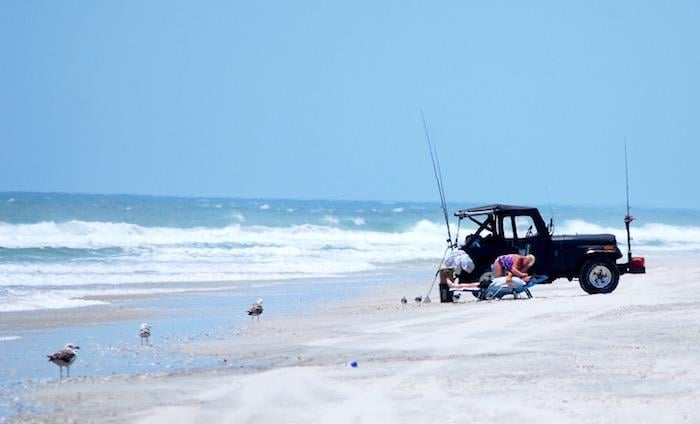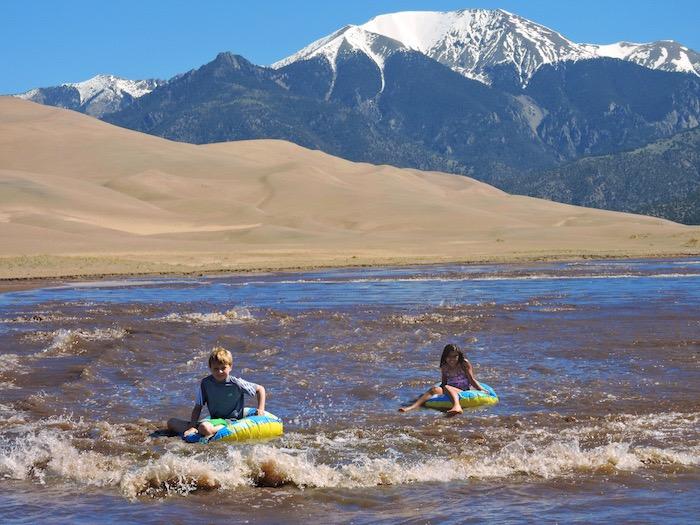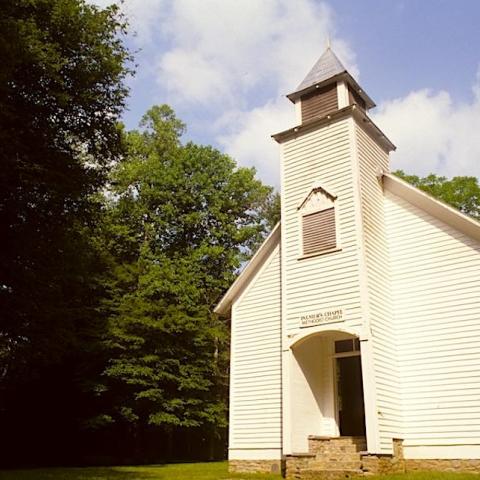Judging from last year’s head count in the National Park System—a record 307.2 million—you can pretty much be assured that many parks will be even more crowded this summer as the National Park Service Centennial is celebrated.
Crowds already are turning out in some parks. In Utah, Zion National Park, which saw a 14.4 percent increase in visitation in 2015, to 3.64 million, seems poised to break that mark this year. In mid-February there were days when the park closed off private vehicle access to Zion Canyon Scenic Drive because there were no more “legal” parking spots.
You can expect similar crowds this summer in such iconic parks as Yellowstone, Great Smoky Mountains, and the Blue Ridge Parkway. So what are some possible ways to avoid the biggest crowds?
Obvious strategies include:
* Plan your adventures to visit the most popular parks or the most popular part of parks during non-peak times.
* Head to a less-crowded area of the park, something that could still be difficult this year.
* Schedule your visit to the most popular parks for 2017 or even 2018 and visit less well-known parks in 2016.
Beyond those options, there are many “sleeper park” alternatives that will surprise you with their beauty and recreational or cultural offerings.
Let’s take a look at a few possibilities:
This small park—76,518 acres—packs an incredible number of stone arches and windows into the landscape. And that’s why it attracts so many visitors: a record 1.4 million last year, or a nearly 9 percent increase over 2014. So many visitors tried to get in during the Memorial Day Weekend last year that the Utah Highway Patrol temporarily closed the park’s entrance as traffic was backing up onto U.S. 191.
Other possibilities in the general vicinity include Natural Bridges National Monument 124 miles to the southwest, or soaking up some Native American history at Hovenweep National Monument 122 miles to the southeast.
At any of these parks, keep in mind that summertime day temperatures can be high and flash floods are a possibility in some areas. Late September or October, after school starts, might give you more breathing room.
Blue Ridge Parkway, Virginia/North Carolina
With more than 15 million visitors in 2015, this unit continues to top the entire National Park System in terms of annual visits. Which can be nerve-rattling at times. Turn your eyes south to the Natchez Trace Parkway (5.8 million annual visitors) and you’ll find another gorgeous, landscape-hugging drive with only about one-third of the traffic that its northern neighbor has.

There are places at Cape Lookout National Seashore where birds outnumber humans/Kurt Repanshek
Cape Hatteras National Seashore, North Carolina
This national seashore, which counted 2.3 million visitors in 2015, can fill up in the summer months with surfers, surf casters, beachcombers, and other folks looking to cool off in the Atlantic. A less-crowded alternative is to head just a bit south of Cape Hatteras to Cape Lookout National Seashore. Same Outer Banks of North Carolina, but much less developed and much quieter. It’s gorgeous, peaceful, and a little bit on the wild side thanks to the lack of infrastructure. Yet little more than 400,000 people visited last year. Lucky people!
Glacier National Park, Montana
While Glacier’s 2015 visitation—2.34 million — was just slightly higher than 2014’s, the summer’s smoky forest fires that limited access at times no doubt were a factor. Expect greater visitation this year if fires don’t intrude. Consider camping at Bowman Lake, or Kintla Lake, both on the western side of the park, or head to the Two Medicine Campground on the southeastern corner of the park. You could also add a side trip to the north across the border to Waterton Lakes—part of the Waterton-Glacier National Peace Park. If you have time you could also explore Canada’s Banff or Kootenay national parks.
Great Smoky Mountains National Park, North Carolina/Tennessee
The Smokies are a summertime magnet for folks hoping to get some relief from the heat and humidity. But that relief often comes with crowds: 10.7 million visitors last year. What are other possibilities? You could head into the backcountry for a few days. Or travel to the Big South Fork National River and Recreation Area on the Kentucky/Tennessee border with its more than 125,000 backwoods acreage. Get some river-running in, or check into the Charit Creek Lodge, which at roughly 200 years old is the oldest operating lodge in the National Park System. It also has cabins, tree tents and tent sites – but don’t wait too long to make reservations.

Kids don't have to go far for entertainment at Great Sand Dunes National Park/NPS
Rocky Mountain National Park, Colorado
Roughly 5.5 hours south of Rocky rises Great Sand Dunes National Park and Preserve, a destination with not only North America’s tallest sand dunes, but also some alpine lakes and even tundra. This is a park with more than one angle to explore. After sandboarding down some of the dunes a short walk from the visitor’s center at Medano Creek, head to the high country (high-clearance, four-wheel drive vehicle required) to Medano Pass at 9,982 feet, park your rig, and hike to Medano Lake at 11,358 feet. The park also has some special options for better accessibility.
Yellowstone National Park, Wyoming
Yes, you should see Old Faithful at least once in your lifetime. But this year you might be sharing the view with many, many more visitors. You might want to consider day hikes or heading into the backcountry (permit required for overnight stays) to escape the crowds. If that’s not an option, try to relax if you become stuck in a bison or bear jam or while waiting for your 9 p.m. dinner reservation. A less-crowded, and strikingly beautiful, option would be Lassen Volcanic National Park in northern California. This gorgeous park draws few crowds – just 468,092 visitors last year – and has a thermal area, Bumpass Hell, which looks as if it was transplanted from Yellowstone’s Norris Geyser Basin.
Yosemite National Park, California
Yosemite is spectacular…but it’s also crowded. If you’re itching for a fix of granite domes, deep canyons, glacially carved mountains, and alpine lakes without the crowds, consider traveling just a bit south to Kings Canyon National Park. This granitic beauty was enjoyed by fewer than 500,000 folks in 2015, vs. the 4.1 million that flocked to Yosemite.
While Zion is breathtaking, it’s even more so when you’re not elbow-to-elbow or waiting in long lines for the shuttle bus into Zion Canyon Scenic Drive. Another possibility is to head to Capitol Reef National Park just a little more than three hours to the northeast, in central Utah. With nearly 100,000 more acres to explore, Capitol Reef is vastly underrated as a destination….and had 2.7 million fewer visitors last year. The Fruita Campground is wonderful, there are canyons nearby to explore (though not as deep as Zion Canyon), and the spectacular scenery awaits those who venture to Cathedral Valley.

Capitol Reef National Park, with its amazing geology and sparse crowds, is a good alternative to Zion National Park/NPS
Here’s a glance at some other units of the National Park System that actually saw decreases in visitation last year and so might be wise destinations this year.
• Big Cypress National Preserve in Florida, an incredibly rich preserve of flora and fauna, saw visitation decrease 80,566 last year. While summer probably isn’t the best time to visit, fall into winter can be wonderful.
• Chesapeake and Ohio Canal National Historical Park in Maryland, West Virginia, and the District of Columbia was down 267,907 in visitation last year. With its rich American history, the tow paths to walk, areas to canoe, and the Canal Quarters program that lets you spend a night or two in a lock-keeper’s house, this park is an overlooked gem.
• In Arizona, Petrified Forest National Park visitation was down 43,574 last year to just under 800,000. While you can’t stay overnight a lodge in the park, you can roam from the main overlooks into the backcountry for day hikes (overnight stays require a permit) to marvel at chunks of petrified wood, pictographs, and rugged badlands. Just make sure you can retrace your steps to your rig and don’t become a search-and-rescue candidate.
• The Natchez Trace Parkway was down 60,662, which really is little more than a rounding error, as annual visitation was 5.8 million. Still, this scenic drive offers spurs to interesting sights that recount poignant moments in American history, such as Shiloh National Military Park (which was down 52,551); Vicksburg National Military Park (which was off 18,430); Tupelo National Battlefield, and; Natchez Trace National Historical Park.
• Study the launching point of the American Revolution at Minute Man National Historical Park in Massachusetts; visitation was off by almost 100,000 last year. Then head to the coast and Salem Maritime National Historic Site, where you can hear “stories of the sailors, Revolutionary War privateers, and merchants who brought the riches of the world to America.”
• Voyageurs National Park in Minnesota was basically flat, visitation-wise, in 2015 compared to 2014. But with only 238,313 visitors, this is not a crowded park by any stretch of the imagination. And with its backcountry lakes and campsites, you can find solitude.
With a small amount of careful planning, you can find your park in 2016. And you can find one without being overwhelmed by crowds.






 Support Essential Coverage of Essential Places
Support Essential Coverage of Essential Places







Comments
Bumpass Hell not Bumpus Hell
http://www.nps.gov/lavo/planyourvisit/hiking_bumpass_hell.htm
Good catch, spellchecker. We fixed it.
Traveler, just a moment to thank you all for the great photo's. Tea Kettle junction, been there 4-5 times, but not recently. I see there are mucho more teapots hanging from the sign.
When we were in the Boston area for a wedding years ago, Salem Maritime was a fun visit, including wandering the replica tall ship they have. Plus it was only a few minute walk from the [non-NPS] Salem Witch Museum, another interesting wander.
I live 20-25 miles from Minuteman National Park. The 100,000 decrease may be a little deceptive. We had the worst winter since records have been kept last year. People could not get to work for several days in January, February and March, so I imagine that for about 10 weeks hardly anyone went to that park. After that period, things were still covered in snow and it was cold.
However, I know those of you in Salt Lake City have winters like that every year, right?